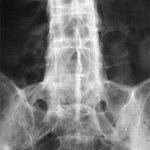This study has raised important issues in several contexts. First, there is the conceptual issue that intraarticular persistence of pathogens may trigger a chronic inflammatory process that may be sustained, possibly for years. Secondly, the ambiguity in nomenclature becomes readily apparent, as it has been the case for Lyme arthritis. If the inflammatory process is terminated with antibiotic treatment, it could be argued that the treated condition meets a reasonable operational definition of septic arthritis, rather than reactive arthritis. Finally, the clinical implications are significant. The subjects in this study had a long-standing seronegative arthritis that had proved refractory to both nonsteroidal antiinflammatory drugs and disease-modifying anti-rheumatic drug treatment. This raises a very pertinent clinical question: How many patients currently classified as undifferentiated SpA might be effectively treated with antibiotics? It is a question for which Dr. Osler would have urged an answer.
Send Us a Letter!
Contact us at:
David Pisetsky, MD, PhD, physician editor
E-mail: [email protected]
Dawn Antoline, editor,
E-mail: [email protected]
Phone: (201) 748-7757
The Rheumatologist welcomes letters to the editor. Letters should be 500 words or less, and may be edited for length and style. Include your name, title, and organization, as well as a daytime phone number.
Self/Nonself Complexities Arising
In the original formulation of the underlying principles of the innate immune response, perfect self/nonself discrimination was proposed as the one of the cardinal features because the pathogen associated molecular patterns (PAMPs) recognized by host innate immune receptors were so different from endogenous host ligands so as to never allow a case of mistaken identity. A PAMP was the molecular passport of an alien.
But what should happen in the event that an alien has not only invaded our home and native land, but has become enculturated and fully assimilated into the society? Such was the case with the bacterial symbionts of antiquity that invaded eukayotic cells, set up distinct societies, and in time became mitochondria. But, a genetic footprint of this event was left behind: our mitochondrial DNA retains significant sequences of bacterial DNA.22 With respect to immune recognition, this is far more profound—and more unnerving—than molecular mimicry of host and microbial determinants. This is molecular identity of host and microbial determinants.
What would transpire if the mitochondrial DNA were released systemically, as might occur following trauma? That might occasion a response that was indistinguishable from sepsis, which seems unlikely—yet that is precisely what occurs. The binding of mitochondrial DNA to TLR9 on the surface of neutrophils initiates activation of neutrophils and release of IL-8 in a way that looks just like an infection (see Figure 2, above left).23 Indeed, infusion of mitochondrial DNA alone initiates an intense pneumonitis similar to that seen in the systemic inflammatory response syndrome that occurs after trauma. This recognition is changing the landscape of the concept of infection. Perhaps the enemy has been lurking within all along. With respect to host immune response, perhaps we have met the enemy—and it is us.


